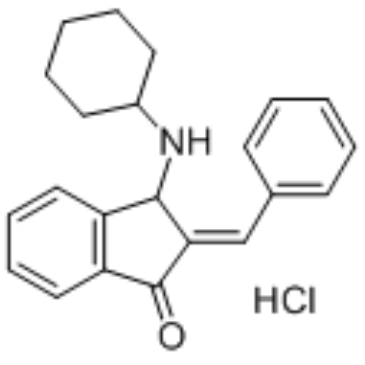95130-23-7
| Name | 1H-Inden-1-one, 3-(cyclohexylamino)-2,3-dihydro-2-(phenylmethylen e)-, chloride (1:1) |
|---|---|
| Synonyms | MFCD16875416 |
| Description | (E/Z)-BCI hydrochloride is a DUSP6 inhibitor with anti-inflammatory activities. (E/Z)-BCI hydrochloride attenuates LPS-induced inflammatory mediators and ROS production in macrophage cells via activating the Nrf2 signaling axis and inhibiting the NF-κB pathway [1]. |
|---|---|
| Related Catalog | |
| Target |
DUSP6[1] |
| In Vitro | (E/Z)-BCI hydrochloride (2-10 μM; 72 hours) significantly decreases cell viability in a time and dose-dependent manner in gastric epithelial cell GES1, GC cell lines, and AGS cell lines[2]. (E/Z)-BCI hydrochloride (0.5-4 μM; 24 hours) significantly inhibits DUSP6 expression in LPS-activated macrophages[1]. (E/Z)-BCI hydrochloride decreases ROS production and activates the Nrf2 pathway in LPS-activated macrophages[1]. Cell Proliferation Assay[2] Cell Line: Gastric epithelial cell GES1, GC cell lines (HGC27, SGC7901, MKN45, BGC823, MGC803, SNU216, NUGC4), AGS cell lines Concentration: 2 μM, 4 μM, 6 μM, 8 μM, 10 μM Incubation Time: 72 hours Result: Cell viability was significantly decreased in a time and dose-dependent manner. Western Blot Analysis[1] Cell Line: RAW264.7 macrophage cells (by LPS-activated macrophages) Concentration: 0.5 μM, 1 μM, 2 μM, 4 μM Incubation Time: 24 hours Result: DUSP6 protein was significantly downregulated in LPS-activated macrophages. |
| In Vivo | (E/Z)-BCI hydrochlorideenhance (35 mg/kg; i.p. injection; every 7 days for four weeks) enhances cisplatin efficacy in PDX models[2]. Animal Model: Patient-derived xenograft (PDX) models (Four- to five-week-old female BALB/c nude mice) [2] Dosage: 35 mg/kg Administration: i.p. injection; every 7 days by for four weeks Result: Tumor weights in the PDX models treated plus CDDP were significantly suppressed compared with tumors from PDX model mice treated with either agent alone. |
| References |
| Boiling Point | 484.6ºC at 760mmHg |
|---|---|
| Molecular Formula | C22H24ClNO |
| Molecular Weight | 353.89 |
| Flash Point | 161.3ºC |
| Exact Mass | 352.14700 |
| PSA | 29.10000 |
| LogP | 2.32480 |
| RIDADR | NONH for all modes of transport |
|---|
